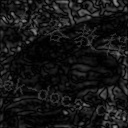将imori.jpg灰度化之后进行傅立叶变换并进行带通滤波,之后再用傅立叶逆变换复原吧!
在这里,我们使用可以保留介于低频成分和高频成分之间的分量的带通滤波器。在这里,我们使用可以去除低频部分,只保留高频部分的高通滤波器。假设从低频的中心到高频的距离为r,我们保留0.1\ r至0.5\ r的分量。
python实现:
import cv2
import numpy as np
import matplotlib.pyplot as plt
# DFT hyper-parameters
K, L = 128, 128
channel = 3
# bgr -> gray
def bgr2gray(img):
gray = 0.2126 * img[..., 2] + 0.7152 * img[..., 1] + 0.0722 * img[..., 0]
return gray
# DFT
def dft(img):
# Prepare DFT coefficient
G = np.zeros((L, K, channel), dtype=np.complex)
# prepare processed index corresponding to original image positions
x = np.tile(np.arange(W), (H, 1))
y = np.arange(H).repeat(W).reshape(H, -1)
# dft
for c in range(channel):
for l in range(L):
for k in range(K):
G[l, k, c] = np.sum(img[..., c] * np.exp(-2j * np.pi * (x * k / K + y * l / L))) / np.sqrt(K * L)
#for n in range(N):
# for m in range(M):
# v += gray[n, m] * np.exp(-2j * np.pi * (m * k / M + n * l / N))
#G[l, k] = v / np.sqrt(M * N)
return G
# IDFT
def idft(G):
# prepare out image
H, W, _ = G.shape
out = np.zeros((H, W, channel), dtype=np.float32)
# prepare processed index corresponding to original image positions
x = np.tile(np.arange(W), (H, 1))
y = np.arange(H).repeat(W).reshape(H, -1)
# idft
for c in range(channel):
for l in range(H):
for k in range(W):
out[l, k, c] = np.abs(np.sum(G[..., c] * np.exp(2j * np.pi * (x * k / W + y * l / H)))) / np.sqrt(W * H)
# clipping
out = np.clip(out, 0, 255)
out = out.astype(np.uint8)
return out
# BPF
def bpf(G, ratio1=0.1, ratio2=0.5):
H, W, _ = G.shape
# transfer positions
_G = np.zeros_like(G)
_G[:H//2, :W//2] = G[H//2:, W//2:]
_G[:H//2, W//2:] = G[H//2:, :W//2]
_G[H//2:, :W//2] = G[:H//2, W//2:]
_G[H//2:, W//2:] = G[:H//2, :W//2]
# get distance from center (H / 2, W / 2)
x = np.tile(np.arange(W), (H, 1))
y = np.arange(H).repeat(W).reshape(H, -1)
# make filter
_x = x - W // 2
_y = y - H // 2
r = np.sqrt(_x ** 2 + _y ** 2)
mask = np.ones((H, W), dtype=np.float32)
mask[(r < (W // 2 * ratio1)) | (r > (W // 2 * ratio2))] = 0
mask = np.repeat(mask, channel).reshape(H, W, channel)
# filtering
_G *= mask
# reverse original positions
G[:H//2, :W//2] = _G[H//2:, W//2:]
G[:H//2, W//2:] = _G[H//2:, :W//2]
G[H//2:, :W//2] = _G[:H//2, W//2:]
G[H//2:, W//2:] = _G[:H//2, :W//2]
return G
# Read image
img = cv2.imread("imori.jpg").astype(np.float32)
H, W, C = img.shape
# Gray scale
gray = bgr2gray(img)
# DFT
G = dft(img)
# BPF
G = bpf(G, ratio1=0.1, ratio2=0.5)
# IDFT
out = idft(G)
# Save result
cv2.imshow("result", out)
cv2.waitKey(0)
cv2.imwrite("out.jpg", out)
C++实现:
#include <opencv2/core.hpp>
#include <opencv2/highgui.hpp>
#include <iostream>
#include <math.h>
#include <complex>
const int height = 128, width = 128;
struct fourier_str {
std::complex<double> coef[height][width];
};
// RGB to Gray scale
cv::Mat BGR2GRAY(cv::Mat img){
// prepare output
cv::Mat out = cv::Mat::zeros(height, width, CV_8UC1);
// BGR -> Gray
for (int y = 0; y < height; y++){
for (int x = 0; x < width; x++){
out.at<uchar>(y, x) = (int)((float)img.at<cv::Vec3b>(y, x)[0] * 0.0722 + \
(float)img.at<cv::Vec3b>(y, x)[1] * 0.7152 + \
(float)img.at<cv::Vec3b>(y, x)[2] * 0.2126);
}
}
return out;
}
// Discrete Fourier transformation
fourier_str dft(cv::Mat img, fourier_str fourier_s){
double I;
double theta;
std::complex<double> val;
for ( int l = 0; l < height; l ++){
for ( int k = 0; k < width; k ++){
val.real(0);
val.imag(0);
for ( int y = 0; y < height; y ++){
for ( int x = 0; x < width; x ++){
I = (double)img.at<uchar>(y, x);
theta = -2 * M_PI * ((double)k * (double)x / (double)width + (double)l * (double)y / (double)height);
val += std::complex<double>(cos(theta), sin(theta)) * I;
}
}
val /= sqrt(height * width);
fourier_s.coef[l][k] = val;
}
}
return fourier_s;
}
// Inverse Discrete Fourier transformation
cv::Mat idft(cv::Mat out, fourier_str fourier_s){
double theta;
double g;
std::complex<double> G;
std::complex<double> val;
for ( int y = 0; y < height; y ++){
for ( int x = 0; x < width; x ++){
val.real(0);
val.imag(0);
for ( int l = 0; l < height; l ++){
for ( int k = 0; k < width; k ++){
G = fourier_s.coef[l][k];
theta = 2 * M_PI * ((double)k * (double)x / (double)width + (double)l * (double)y / (double)height);
val += std::complex<double>(cos(theta), sin(theta)) * G;
}
}
g = std::abs(val) / sqrt(height * width);
g = fmin(fmax(g, 0), 255);
out.at<uchar>(y, x) = (uchar)g;
}
}
return out;
}
// Band pass Filter
fourier_str bpf(fourier_str fourier_s, double pass_lower, double pass_upper){
// filtering
int r = height / 2;
int filter_lower = (int)((double)r * pass_lower);
int filter_upper = (int)((double)r * pass_upper);
for ( int j = 0; j < height / 2; j++){
for ( int i = 0; i < width / 2; i++){
if ((sqrt(i * i + j * j) < filter_lower) ||
(sqrt(i * i + j * j) > filter_upper)){
fourier_s.coef[j][i] = 0;
fourier_s.coef[j][width - i] = 0;
fourier_s.coef[height - i][i] = 0;
fourier_s.coef[height - i][width - i] = 0;
}
}
}
/*
fourier_str tmp_s;
// region change
for ( int j = 0; j < height / 2; j++){
for ( int i = 0; i < width / 2; i++){
// left top > right bottom
tmp_s.coef[height / 2 + j][width / 2 + i] = fourier_s.coef[j][i];
// right top > left bottom
tmp_s.coef[height / 2 + j][i] = fourier_s.coef[j][width / 2 + i];
// left bottom > right top
tmp_s.coef[j][width / 2 + i] = fourier_s.coef[height / 2 + j][i];
// right bottom > left top
tmp_s.coef[j][i] = fourier_s.coef[height / 2 + j][width / 2 + i];
}
}
// filtering
int r = height / 2;
int filter_d = (int)((double)r / 2);
for ( int j = 0; j < height / 2; j++){
for ( int i = 0; i < width / 2; i++){
if (sqrt(i * i + j + j) >= filter_d){
tmp_s.coef[height / 2 - j][width / 2 + i] = 0;
tmp_s.coef[height / 2 - j][width / 2 - i] = 0;
tmp_s.coef[height / 2 + i][width / 2 + i] = 0;
tmp_s.coef[height / 2 + i][width / 2 - i] = 0;
}
}
}
// return region
for ( int j = 0; j < height / 2; j++){
for ( int i = 0; i < width / 2; i++){
// left top > right bottom
fourier_s.coef[height / 2 + j][width / 2 + i] = tmp_s.coef[j][i];
// right top > left bottom
fourier_s.coef[height / 2 + j][i] = tmp_s.coef[j][width / 2 + i];
// left bottom > right top
fourier_s.coef[j][width / 2 + i] = tmp_s.coef[height / 2 + j][i];
// right bottom > left top
fourier_s.coef[j][i] = tmp_s.coef[height / 2 + j][width / 2 + i];
}
}
*/
return fourier_s;
}
// Main
int main(int argc, const char* argv[]){
// read original image
cv::Mat img = cv::imread("imori.jpg", cv::IMREAD_COLOR);
// Fourier coefficient
fourier_str fourier_s;
// output image
cv::Mat out = cv::Mat::zeros(height, width, CV_8UC1);
// BGR -> Gray
cv::Mat gray = BGR2GRAY(img);
// DFT
fourier_s = dft(gray, fourier_s);
// HPF
fourier_s = bpf(fourier_s, 0.1, 0.5);
// IDFT
out = idft(out, fourier_s);
//cv::imwrite("out.jpg", out);
cv::imshow("answer", out);
cv::waitKey(0);
cv::destroyAllWindows();
return 0;
}
输入:

输出:

 极客教程
极客教程